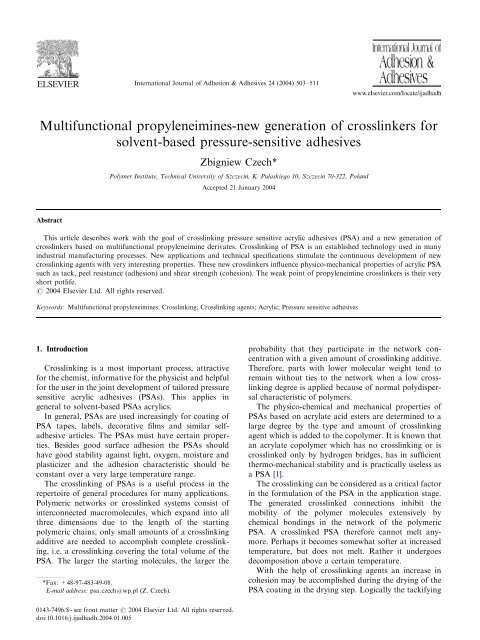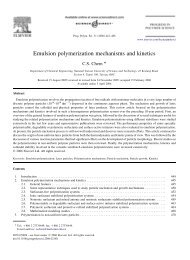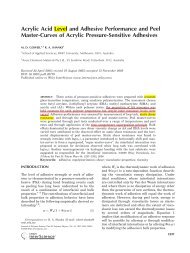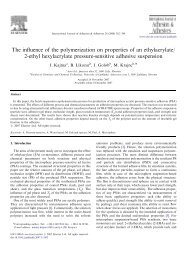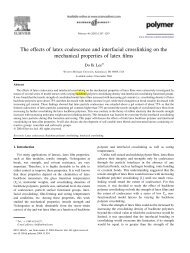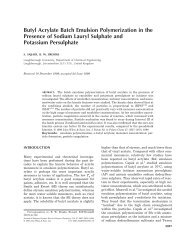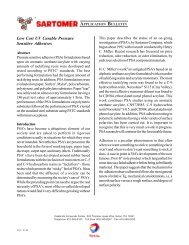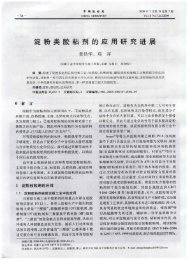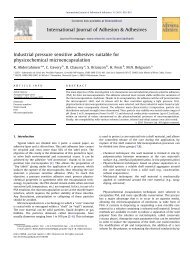Multifunctional propyleneimines-new generation of crosslinkers for ...
Multifunctional propyleneimines-new generation of crosslinkers for ...
Multifunctional propyleneimines-new generation of crosslinkers for ...
You also want an ePaper? Increase the reach of your titles
YUMPU automatically turns print PDFs into web optimized ePapers that Google loves.
ARTICLE IN PRESS<br />
International Journal <strong>of</strong> Adhesion & Adhesives 24 (2004) 503–511<br />
<strong>Multifunctional</strong> <strong>propyleneimines</strong>-<strong>new</strong> <strong>generation</strong> <strong>of</strong> <strong>crosslinkers</strong> <strong>for</strong><br />
solvent-based pressure-sensitive adhesives<br />
Zbigniew Czech*<br />
Polymer Institute, Technical University <strong>of</strong> Szczecin, K. Pulaskiego 10, Szczecin 70-322, Poland<br />
Accepted 21 January 2004<br />
Abstract<br />
This article describes work with the goal <strong>of</strong> crosslinking pressure sensitive acrylic adhesives (PSA) and a <strong>new</strong> <strong>generation</strong> <strong>of</strong><br />
<strong>crosslinkers</strong> based on multifunctional propyleneimine derivates. Crosslinking <strong>of</strong> PSA is an established technology used in many<br />
industrial manufacturing processes. New applications and technical specifications stimulate the continuous development <strong>of</strong> <strong>new</strong><br />
crosslinking agents with very interesting properties. These <strong>new</strong> <strong>crosslinkers</strong> influence physico-mechanical properties <strong>of</strong> acrylic PSA<br />
such as tack, peel resistance (adhesion) and shear strength (cohesion). The weak point <strong>of</strong> propyleneimine <strong>crosslinkers</strong> is their very<br />
short potlife.<br />
r 2004 Elsevier Ltd. All rights reserved.<br />
Keywords: <strong>Multifunctional</strong> <strong>propyleneimines</strong>; Crosslinking; Crosslinking agents; Acrylic; Pressure sensitive adhesives<br />
1. Introduction<br />
Crosslinking is a most important process, attractive<br />
<strong>for</strong> the chemist, in<strong>for</strong>mative <strong>for</strong> the physicist and helpful<br />
<strong>for</strong> the user in the joint development <strong>of</strong> tailored pressure<br />
sensitive acrylic adhesives (PSAs). This applies in<br />
general to solvent-based PSAs acrylics.<br />
In general, PSAs are used increasingly <strong>for</strong> coating <strong>of</strong><br />
PSA tapes, labels, decorative films and similar selfadhesive<br />
articles. The PSAs must have certain properties.<br />
Besides good surface adhesion the PSAs should<br />
have good stability against light, oxygen, moisture and<br />
plasticizer and the adhesion characteristic should be<br />
constant over a very large temperature range.<br />
The crosslinking <strong>of</strong> PSAs is a useful process in the<br />
repertoire <strong>of</strong> general procedures <strong>for</strong> many applications.<br />
Polymeric networks or crosslinked systems consist <strong>of</strong><br />
interconnected macromolecules, which expand into all<br />
three dimensions due to the length <strong>of</strong> the starting<br />
polymeric chains, only small amounts <strong>of</strong> a crosslinking<br />
additive are needed to accomplish complete crosslinking,<br />
i.e. a crosslinking covering the total volume <strong>of</strong> the<br />
PSA. The larger the starting molecules, the larger the<br />
*Fax: +48-97-483-49-08.<br />
E-mail address: psa czech@wp.pl (Z. Czech).<br />
probability that they participate in the network concentration<br />
with a given amount <strong>of</strong> crosslinking additive.<br />
There<strong>for</strong>e, parts with lower molecular weight tend to<br />
remain without ties to the network when a low crosslinking<br />
degree is applied because <strong>of</strong> normal polydispersal<br />
characteristic <strong>of</strong> polymers.<br />
The physico-chemical and mechanical properties <strong>of</strong><br />
PSAs based on acrylate acid esters are determined to a<br />
large degree by the type and amount <strong>of</strong> crosslinking<br />
agent which is added to the copolymer. It is known that<br />
an acrylate copolymer which has no crosslinking or is<br />
crosslinked only by hydrogen bridges, has in sufficient<br />
thermo-mechanical stability and is practically useless as<br />
a PSA [1].<br />
The crosslinking can be considered as a critical factor<br />
in the <strong>for</strong>mulation <strong>of</strong> the PSA in the application stage.<br />
The generated crosslinked connections inhibit the<br />
mobility <strong>of</strong> the polymer molecules extensively by<br />
chemical bondings in the network <strong>of</strong> the polymeric<br />
PSA. A crosslinked PSA there<strong>for</strong>e cannot melt anymore.<br />
Perhaps it becomes somewhat s<strong>of</strong>ter at increased<br />
temperature, but does not melt. Rather it undergoes<br />
decomposition above a certain temperature.<br />
With the help <strong>of</strong> crosslinking agents an increase in<br />
cohesion may be accomplished during the drying <strong>of</strong> the<br />
PSA coating in the drying step. Logically the tackifying<br />
0143-7496/$ - see front matter r 2004 Elsevier Ltd. All rights reserved.<br />
doi:10.1016/j.ijadhadh.2004.01.005
504<br />
ARTICLE IN PRESS<br />
Z. Czech / International Journal <strong>of</strong> Adhesion & Adhesives 24 (2004) 503–511<br />
properties <strong>of</strong> the PSA coat, such as tack and peel<br />
adhesion decrease (Fig. 1).<br />
The time span, which can be utilized after the<br />
crosslinking agent containing PSAs is set up, is called<br />
pot life. After a second time span the so-called gel point<br />
is reached, and the PSA can no longer be modified. This<br />
process is illustrated below (Fig. 2).<br />
The curve in general applies to each crosslinking<br />
agent containing PSA system. That means that a fast<br />
crosslinking systemhas actually a short pot life, and a<br />
slow crosslinking systemhas a long pot life. Fast<br />
crosslinking PSA systems <strong>for</strong> industrial use with short<br />
pot life are <strong>of</strong>ten used with two-component applicationequipment,<br />
which mix and add the reactive components<br />
right be<strong>for</strong>e the coating [4].<br />
In order to develope the solvent-based PSA crosslinking,<br />
various multifunctional chemical compounds<br />
with respectively reactive groups are used as the<br />
following list illustrates:<br />
* metal acidesters [5],<br />
* metal chelates [6],<br />
* metal salts [7],<br />
tack, adhesion<br />
25<br />
20<br />
15<br />
10<br />
5<br />
0<br />
tack<br />
cohesion<br />
crosslinker amount<br />
adhesion<br />
Fig. 1. Crosslinkage density influence on tack, peel, adhesion and<br />
cohesion [2].<br />
viscosity (Pas)<br />
12<br />
10<br />
8<br />
6<br />
4<br />
2<br />
coating level<br />
pot life<br />
gel point<br />
0<br />
0 1 2 3 4 5 6 7<br />
time (h)<br />
Fig. 2. Viscosity dependence <strong>of</strong> time by crosslinker containing PSAs<br />
[3].<br />
cohesion<br />
* polyfunctional isocyanates [8],<br />
* organ<strong>of</strong>unctional silanes [9],<br />
* polycarbodiimides [10],<br />
* polyfunctional ethyleneimines [11],<br />
* polyfunctional <strong>propyleneimines</strong> [12],<br />
* amino resins [13],<br />
* epoxy resins [14].<br />
1.1. <strong>Multifunctional</strong> propyleneimine derivatives<br />
In order to achieve optimum crosslinking efficiency,<br />
the known terrain <strong>of</strong> <strong>crosslinkers</strong> was widened by the<br />
introduction <strong>of</strong> a <strong>new</strong> <strong>generation</strong> <strong>of</strong> <strong>crosslinkers</strong>, multifunctional<br />
<strong>propyleneimines</strong> derived from 2-methylaziridine<br />
containing saturated unstable rings with nitrogen<br />
atoms.<br />
Such compounds react with the carboxyl groups or<br />
isocyanate groups <strong>of</strong> the polymer by opening the ring.<br />
This classifies themas <strong>crosslinkers</strong>.<br />
The crosslinking <strong>of</strong> carboxyl group containing pressure<br />
sensitive adhesives is carried out under room<br />
temperature, an increase <strong>of</strong> temperature accelerates the<br />
crosslinking process. Because <strong>of</strong> the high reactivity <strong>of</strong><br />
polyaziridines the pot life <strong>of</strong> propyleneimine containing<br />
PSA <strong>for</strong>mulations is quite limited and lies in the range <strong>of</strong><br />
2– 8 h which is lower than the pot life <strong>of</strong> polyisocyanate<br />
containing adhesives. This problemcan be overcome by<br />
mixing the adhvesive mass and the crosslinker directly<br />
prior to the coating step. In comparison to metal acid<br />
esters or metal chelates the crosslinking yield <strong>of</strong> multifunctional<br />
<strong>propyleneimines</strong> is so high that no afterreactions<br />
like brittleness or a decline <strong>of</strong> peel resistance<br />
due to ongoing crosslinking occur.<br />
1.2. Reaction mechanism <strong>of</strong> crosslinking<br />
The crosslinking <strong>of</strong> pressure sensitive adhesives with<br />
multifunctional <strong>propyleneimines</strong> is mainly based on the<br />
carboxyl groups <strong>of</strong>fered by the vinylcarbonic acids<br />
within the polymeric chain. The oxygen <strong>of</strong> the nucleophilic<br />
carboxyl group causes the opening <strong>of</strong> the tense<br />
propyleneimine rings while the hydrogen atoms accompanying<br />
the carboxyl groups protonate the nitrogen<br />
atoms (Fig. 3).<br />
Such a crosslinking variation involves the following<br />
consideration (Fig. 4).<br />
Concidering the carbon-cation-structure the variant<br />
2 seems to be the most realistic path backing the<br />
reaction mechanism shown above.<br />
General multifunctional propyleneimine groups containing<br />
compounds are known <strong>for</strong> over 35 years. Along<br />
with the progress in the field <strong>of</strong> organic synthesis the<br />
chemical structure <strong>of</strong> propyleneimine <strong>crosslinkers</strong> was<br />
adapted to the developments in polymer chemistry. The<br />
application <strong>of</strong> such <strong>crosslinkers</strong> is product oriented and<br />
only mentioned <strong>for</strong> special <strong>for</strong>mulations. In the early
ARTICLE IN PRESS<br />
Z. Czech / International Journal <strong>of</strong> Adhesion & Adhesives 24 (2004) 503–511 505<br />
O<br />
O<br />
Polymer C OH<br />
N R N HO C Polymer<br />
CH 3 CH 3<br />
O<br />
H H<br />
O<br />
Polymer C O<br />
CH 3<br />
N R N<br />
CH 3<br />
O C Polymer<br />
H O O<br />
2 C<br />
CH 2<br />
N C R C N<br />
H 3 C HC<br />
CH CH 3<br />
Fig. 5. Structure <strong>of</strong> bisamide crosslinking agents.<br />
O<br />
Polymer C<br />
O<br />
CH 3 CH<br />
CH 2 NH R NH CH 2 CH CH 3<br />
O<br />
O<br />
C<br />
Polymer<br />
CH<br />
H 2 C<br />
3 CH 3<br />
CH<br />
N<br />
N 2<br />
O C N CH CH<br />
HC<br />
2 C CH 2 CH 2 CH 2 N C O CH<br />
CH<br />
CH 3<br />
3 CH 3<br />
O CH 3 CH 3 O<br />
Polymer C O CH CH 2 NH R NH CH 2 CH O C<br />
Polymer<br />
Fig. 3. Crosslinking <strong>of</strong> carboxylated PSA initiated by propyleneimine.<br />
O<br />
CH 3 CH 3<br />
O<br />
H 2 C<br />
CH 2<br />
N C NH CH 2 C CH 2 CH CH 2 CH 2 NH C N<br />
HC<br />
CH<br />
CH<br />
CH 3<br />
3<br />
CH 3<br />
Fig. 6. Synthesis <strong>of</strong> multifunctional propyleneimine from isocyanates<br />
wit 2-methyl-aziridine.<br />
CH 2<br />
1<br />
CH 2<br />
H 1<br />
CH 3 CH NH R<br />
instable carbon cation<br />
N R<br />
2<br />
CH 2<br />
CH 3 CH CH 2 NH R<br />
stable carbon-cation<br />
CH 3<br />
Fig. 4. Crosslinking mechanism by <strong>propyleneimines</strong> [1].<br />
Cl<br />
CH 2<br />
3x HN<br />
+<br />
CH CH<br />
N<br />
3<br />
N<br />
Cl<br />
N<br />
Cl<br />
CH 3<br />
CH 3<br />
N N N<br />
N N<br />
N<br />
CH 3<br />
Fig. 7. 2,4,6-Tris(1-methylaziridinyl)-1,3,5-triazine (tripropylenemelamine).<br />
1980s, 3M was particularly active in this sector<br />
presenting <strong>new</strong> ideas about structure and application<br />
<strong>of</strong> polyfunctional <strong>propyleneimines</strong> [15].<br />
Regarding their chemical structure the multifunctional<br />
propyleneimine <strong>crosslinkers</strong> can be prepared by<br />
the following reactions.<br />
Reaction products from multifunctional carboxylic acid<br />
chlorides and propyleneimine: This range <strong>of</strong> crosslinking<br />
agents is also known as bisamide crosslinking agents<br />
(BCA) (Fig. 5).<br />
Reaction products from multifunctional isocyanates and<br />
propyleneimine: This reaction is based upon the reactivity<br />
<strong>of</strong> the propyleneimine ring and the N¼C¼O-groups<br />
(Fig. 6).<br />
Propyleneimines based on s-triazine: As a result <strong>of</strong> the<br />
reaction between propyleneimine and cyanuric acid<br />
chloride or tris-(2-carboxyethyl)isocyanurate we find<br />
the following crosslinker (Fig. 7).<br />
Reaction products from multifunctional acrylates and<br />
propyleneimine: Propyleneimine reacts with the double<br />
bond <strong>of</strong> the acryloyl group (Fig. 8).<br />
Propyleneimines with central heteroatoms: Mainly<br />
phosphorus and sulfur serve as heteroatoms (Fig. 9).<br />
H 3 C<br />
H 3 C<br />
C 3<br />
H 7<br />
N<br />
N<br />
H 2 C<br />
CH<br />
2. Experimental part<br />
O<br />
C<br />
O<br />
CH 2 CH 2 C<br />
O R O C CH<br />
The following experiments were conducted in order to<br />
study the influence <strong>of</strong> diverse <strong>propyleneimines</strong> such<br />
<strong>crosslinkers</strong> on other important properties <strong>of</strong> pressure<br />
sensitive adhesive such as tack, adhesion and cohesion.<br />
O<br />
CH 2<br />
O<br />
O R O C CH 2 CH 2 N<br />
Fig. 8. Reaction <strong>of</strong> 2-methylaziridine with acryloyl group.<br />
O N<br />
P<br />
N<br />
CH 3<br />
O<br />
O<br />
CH 3 N CH 2 S CH 2 C<br />
CH<br />
N<br />
3<br />
Fig. 9. Propyleneimines with heteroatom.<br />
C<br />
N<br />
CH 3<br />
CH 3<br />
CH 3
506<br />
ARTICLE IN PRESS<br />
Z. Czech / International Journal <strong>of</strong> Adhesion & Adhesives 24 (2004) 503–511<br />
The basic acrylic PSA was prepared from65 parts 2-<br />
ethylhexyl acrylate, 30 parts methyl acrylate and 5 parts<br />
acrylic acid by polymerization in a typical organic<br />
solvent like ethyl acetate. The solid content was about<br />
50% by weight and 2,2 0 -azo-diisobutyronitrile content<br />
was 0.1 wt%. Facing the high reactivity <strong>of</strong> propyleneimine<br />
crosslinker the addition <strong>of</strong> isopropyl alcohol is<br />
necessary.<br />
2-Ethylhexyl acrylate, methyl acrylate, acrylic acid,<br />
isopropyl alcohol and 2,2 0 -azo-diisobutyronitrile are<br />
purchased fromTokyo Chemical Industry Co. (Japan).<br />
The investigated crosslinking agents are available from:<br />
Permutex XR-2500 (Stahl/Holland), Neocryl CX-100<br />
(ICI/England), Trazidin VN (Tramaco/Germany) and<br />
MAPO (Arsynco/USA). Others propylenimine <strong>crosslinkers</strong><br />
were synthesized at Technical University in<br />
Szczecin.<br />
Tack, adhesion and cohesion <strong>of</strong> investigated acrylic<br />
pressure-sensitive adhesives were measured according to<br />
AFERA 4015 (tack), 4001 (adhesion) and 4012 (cohesion).<br />
The synthesized PSAs were crosslinked with investigated<br />
multifunctional <strong>propyleneimines</strong>, at levels <strong>of</strong> 0.1–<br />
0.5 wt%. Since the crosslinking reaction proceeds at<br />
room temperature, the propyleneimine must be added<br />
and mixed just be<strong>for</strong>e the coating operation with 60 g/<br />
m 2 on polyester foil. After mixing, these materials have a<br />
pot life <strong>of</strong> up to 2–6 h be<strong>for</strong>e they gel and become<br />
unusable.<br />
3. Results and discussion<br />
3.1. Influence <strong>of</strong> reaction products from multifunctional<br />
carboxylic acid chlorides and propyleneimine on tack,<br />
adhesion and cohesion<br />
The examples <strong>for</strong> typical reaction products from<br />
multifunctional carboxylic acid chlorides and propyleneimine<br />
are bis-, tri- or tetra-propylencarbonic acid<br />
amides.<br />
It was the aimto examine the influence <strong>of</strong> diverse<br />
synthetized multifunctional acid amides N,N-bis-propylenadipic<br />
acid amide (Fig. 10), 1,1 0 -azelaoyl-bis-(2-<br />
methylaziri-dine) (Fig. 11), N,N 0 ,N 00 ,N 000 -tetrapropylene-1,2,3,4-butanetetracarbonic<br />
acid amide (Fig. 12)<br />
and N,N 0 -bis-propylenisophthalic acide amide (Fig. 13)<br />
as <strong>crosslinkers</strong> on tack, adhesion and cohesion <strong>of</strong><br />
crosslinked PSA acrylics.<br />
The details <strong>of</strong> the investigations carried out are<br />
presented in Figs. 14–18.<br />
As can be seen in Figs. 14 and 15, the tack and<br />
adhesion are considerably reduced and cohesion at 20 C<br />
and at 70 C are improved by the increase <strong>of</strong> propylenimines<br />
concentration. The best crosslinking agent<br />
according to tack and adhesion was 1,1 0 -azelaoyl-bis-<br />
O<br />
O<br />
H 2 C<br />
CH 2<br />
N C CH 2 CH 2 CH 2 CH 2 C N<br />
CH 3 HC CH CH 3<br />
Fig. 10. N,N 0 -bis-propyleneadipic acid amide (BPAA).<br />
O<br />
O<br />
H 2 C<br />
CH 2<br />
N C (CH 2 ) 7 C N<br />
CH 3 HC<br />
CH CH 3<br />
Fig. 11. 1,1 0 -Azelaoyl-bis-(2-methylaziridine) (ABMA).<br />
H 2 C<br />
O<br />
HC<br />
N C CH 2 CH<br />
CH 3<br />
O C<br />
N<br />
H 2 C<br />
CH 3 HC CH 2<br />
CH 3<br />
(2-methylaziridine) (ABMA) with long heptene-chain.<br />
The best crosslinker <strong>for</strong> increase <strong>of</strong> cohesion <strong>of</strong> PSAs<br />
was tatra functional N,N 0 ,N 00 ,N 000 -tetrapropylene-1,2,3,4-<br />
butanetetracarbonic acid amide (TPBA). A very good<br />
balance between tack, adhesion and cohesion was<br />
achieved with aromatic propyleneimine N,N 0 -bis-propyleneisophthalic<br />
acid amide (BPIA).<br />
N<br />
C<br />
CH<br />
CH<br />
O<br />
CH 2<br />
O<br />
C<br />
N<br />
CH 2<br />
CH<br />
CH 3<br />
Fig. 12. N,N 0 ,N 00 ,N 000 -Tetrapropylene-1,2,3,4-butanetetracarbonic acid<br />
amide (TPBA).<br />
tack (N)<br />
24<br />
20<br />
16<br />
12<br />
CH 3<br />
N<br />
O<br />
C<br />
O<br />
C<br />
N<br />
CH 3<br />
Fig. 13. N,N 0 -Bis-propyleneisophthalic acid amide (BPIA).<br />
8<br />
4<br />
0<br />
ABMA<br />
BPAA<br />
BPIA<br />
TPBA<br />
0.1 0.2 0.3 0.4 0.5<br />
propyleneimine amount (wt.%)<br />
Fig. 14. Tack dependence <strong>of</strong> propyleneimine concentration.
ARTICLE IN PRESS<br />
Z. Czech / International Journal <strong>of</strong> Adhesion & Adhesives 24 (2004) 503–511 507<br />
adhesion (N)<br />
24<br />
20<br />
16<br />
12<br />
8<br />
4<br />
ABMA<br />
BPAA<br />
BPIA<br />
TPBA<br />
0<br />
0.1 0.2 0.3 0.4 0.5<br />
propyleneimine amount (wt.%)<br />
Fig. 15. Adhesion dependence <strong>of</strong> propyleneimine concentration.<br />
3.2. Influence <strong>of</strong> reaction products from multifunctional<br />
isocyanates and propyleneimine on tack, adhesion and<br />
cohesion<br />
The synthesis <strong>of</strong> this kind <strong>of</strong> multifunctional aliphatic,<br />
cycloaliphatic or aromatic propylenimines is based upon<br />
the reaction <strong>of</strong> aliphatic, cycloaliphatic or aromatic<br />
multifunctional isocyanates with propyleneimine. The<br />
influence <strong>of</strong> the following investigated propylenimine<br />
crosslinking agents: 1,6-hexamethylendipropyleneurea<br />
(Fig. 18), N,N 0 -bis-propylene-1,4-cyclohexanedicarboxylic<br />
acid amide (Fig. 19), dicyclohexylmethane-bis-<br />
4,4 0 -dipropyleneurea (Fig. 20) and toluene-2,6-dipropylene-urea<br />
(Fig. 21) on tack, adhesion and cohesion was<br />
tested.<br />
120<br />
TPBA<br />
cohesion (N) (20˚C)<br />
100<br />
80<br />
60<br />
40<br />
20<br />
BPIA<br />
ABMA<br />
BPAA<br />
CH 3<br />
N<br />
O<br />
C N<br />
CH 3<br />
C<br />
Fig. 19. N,N 0 -Bis-propylene-1,4-cyclohexanedicarboxylic acid amide<br />
(PCHA).<br />
O<br />
0<br />
0,1 0,2 0,3 0,4 0,5<br />
propyleneimine amount (wt.%)<br />
Fig. 16. Cohesion at 20 C dependence <strong>of</strong> propyleneimine concentration.<br />
O<br />
O<br />
CH 3<br />
N C NH<br />
CH 2 NH C N<br />
CH 3<br />
Fig. 20. Dicyclohexylmethane-bis-4,4 0 -dipropyleneurea (DCDU).<br />
cohesion (N) (70˚C)<br />
40<br />
35<br />
30<br />
25<br />
20<br />
15<br />
10<br />
5<br />
0<br />
BPIA<br />
TPBA<br />
ABMA<br />
BPAA<br />
0.1 0.2 0.3 0.4 0.5<br />
propyleneimine amount (wt.%)<br />
Fig. 17. Cohesion at 70 C dependence <strong>of</strong> propyleneimine concentration.<br />
H 2 C<br />
HC<br />
CH 3<br />
N<br />
O<br />
C<br />
NH<br />
(CH 2 ) 6<br />
NH<br />
O<br />
C<br />
N<br />
CH 2<br />
CH<br />
CH 3<br />
Fig. 18. 1,6-Hexamethylenedipropyleneurea (HMPU).<br />
tack (N)<br />
24<br />
20<br />
16<br />
12<br />
8<br />
4<br />
0<br />
CH 3<br />
O<br />
O<br />
N C NH<br />
NH C N<br />
CH 3<br />
CH 3<br />
Fig. 21. Toluene-2,6-dipropyleneurea (TDPU).<br />
HMPU<br />
PCHA<br />
DCDU<br />
TDPU<br />
0.1 0.2 0.3 0.4 0.5<br />
propyleneimine amount (wt.%)<br />
Fig. 22. Effect <strong>of</strong> propyleneimine amount on tack.
508<br />
ARTICLE IN PRESS<br />
Z. Czech / International Journal <strong>of</strong> Adhesion & Adhesives 24 (2004) 503–511<br />
The results <strong>of</strong> tack, adhesion and cohesion <strong>of</strong> acrylics<br />
pressure-sensitive adhesives are presented in Figs. 22–24.<br />
As expected, the increase <strong>of</strong> propyleneimine content<br />
affects negatively the adhesiveness and positively the<br />
cohesion <strong>of</strong> PSA. The best crosslinker according to<br />
cohesion was aromatic propyleneimine toluene-2,6-<br />
dipropylene-urea (TDPU). The best balance between<br />
tack, adhesion and cohesion was achieved with cycloaliphatic<br />
propyleneimine N,N 0 -bis-propylene-1,4-cyclohexanedicarboxylic<br />
acid amide (PCHA).<br />
adhesion (N)<br />
cohesion (N) at 20˚C and 70 ° C<br />
20<br />
16<br />
12<br />
8<br />
4<br />
0<br />
120<br />
100<br />
80<br />
60<br />
40<br />
20<br />
0<br />
HMPU<br />
TDPU<br />
PCHA<br />
DCDU<br />
0.1 0.2 0.3 0.4 0.5<br />
propyleneimine amount (wt.%)<br />
Fig. 23. Effect <strong>of</strong> propyleneimine amount on adhesion.<br />
20 ° C<br />
70˚C<br />
0.1 0.2 0.3 0.4 0.5 0.6<br />
propyleneimine amount (wt.%)<br />
HMPU<br />
PCHA<br />
DCDU<br />
TDPU<br />
HMPU<br />
PCHA<br />
DCDU<br />
TDPU<br />
Fig. 24. Effect <strong>of</strong> propyleneimine amount on cohesion at 20 C and<br />
70 C.<br />
N<br />
N<br />
N<br />
N<br />
N<br />
CH 3<br />
3.3. Influence <strong>of</strong> <strong>propyleneimines</strong> based on s-triazine on<br />
tack, adhesion and cohesion<br />
As a result <strong>of</strong> the reaction between propyleneimine<br />
and cyanuric acid chloride or tris-(2-carboxyethyl)isocyanurate<br />
the following <strong>crosslinkers</strong> are investigated<br />
(Figs. 25 and 26).<br />
The influence <strong>of</strong> the investigated propyleneimine<br />
crosslinking agents based on s-triazine: 2,4,6-tris(1-<br />
methylaziridinyl)-1,3,5-triazine (tripropylenemelamine)<br />
(Fig. 25) and 2,4,6-tris(propylenepropionic acid<br />
amide)-1,3,5-triazine (Fig. 26) on tack, adhesion and<br />
cohesion was tested and presented in Figs. 27–29.<br />
The obtained PSA acrylics containing propyleneimine<br />
crosslinking agents based on s-triazine have very good<br />
CH 3<br />
tack (N)<br />
adhesion (N)<br />
24<br />
20<br />
16<br />
12<br />
8<br />
4<br />
0<br />
20<br />
16<br />
12<br />
8<br />
N<br />
O<br />
C<br />
CH 2<br />
CH 2<br />
CH 2 CH 2 C N<br />
O<br />
N<br />
CH CH 2 C<br />
N N<br />
O<br />
TPAA<br />
TMTT<br />
0.1 0.2 0.3 0.4 0.5<br />
propyleneimine amount (wt.%)<br />
Fig. 27. Tack dependence <strong>of</strong> propyleneimine content.<br />
TPAA<br />
TMTT<br />
CH 3<br />
CH 3<br />
Fig. 26. 2,4,6-Tris(propylenepropionic acid amide)-1,3,5-triazine<br />
(TPAA).<br />
N<br />
CH 3<br />
CH 3<br />
N<br />
Fig. 25. 2,4,6-Tris(1-methylaziridinyl)-1,3,5-triazine (tripropylenemelamine)<br />
(TMTT).<br />
4<br />
0<br />
0.1 0.2 0.3 0.4<br />
0.5<br />
propyleneimine amount (wt.%)<br />
Fig. 28. Adhesion dependence <strong>of</strong> propyleneimine content.
ARTICLE IN PRESS<br />
Z. Czech / International Journal <strong>of</strong> Adhesion & Adhesives 24 (2004) 503–511 509<br />
cohesion (N) at 20˚C and 70˚C<br />
120<br />
100<br />
80<br />
60<br />
40<br />
20<br />
0<br />
20˚C<br />
70˚C<br />
TMTT<br />
TPAA<br />
TMTT<br />
TPAA<br />
0.1 0.2 0.3 0.4 0.5<br />
propyleneimine amount (wt.%)<br />
Fig. 29. Cohesion dependence <strong>of</strong> propyleneimine content.<br />
tack, adhesion and cohesion. The increase <strong>of</strong> <strong>crosslinkers</strong><br />
concentration from0.1 to 0.5 wt% decreases the<br />
tack and adhesion per<strong>for</strong>mance by factor about 3–4 in<br />
comparison to initial value. The best cohesion was<br />
achieved with 2,4,6-tris(1-methylaziridinyl)-1,3,5-triazine<br />
(tripropylenemelamine) (TMTT).<br />
CH 3<br />
N<br />
N P O<br />
CH 3<br />
N<br />
CH 3<br />
Fig. 30. Tris-(1-(2-methylaziridynyl)phosphinoxide (MAPO).<br />
S<br />
N P N<br />
CH 3 CH 3<br />
N<br />
CH 3<br />
Fig. 31. Tris-1-(2-methyl)aziridinylphosphinesulfide (TAPS).<br />
O<br />
3.4. Influence <strong>of</strong> <strong>propyleneimines</strong> with central heteroatom<br />
on tack, adhesion and cohesion<br />
P<br />
N<br />
N<br />
CH 3<br />
Mainly phosphorus and sulfur serve as heteroatoms<br />
(Figs. 30–32).<br />
Per<strong>for</strong>mance qualities <strong>of</strong> the investigated propyleneimine<br />
crosslinking agents with central heteroatom on<br />
tack, adhesion and cohesion <strong>of</strong> acrylic PSAs are<br />
described in Figs. 33–35.<br />
The increase <strong>of</strong> propyleneimine crosslinker concentration<br />
containing central heteroatomdecrease the peel<br />
properties such as tack and adhesion and increase <strong>of</strong><br />
course the cohesion at 20 C and 70 C. The best<br />
cohesion and also the low tack and adhesion were<br />
achieved with tris-1-(2-methyl)aziridinylphosphinesulfide<br />
(TAPS). In general, it can be said that the use <strong>of</strong><br />
<strong>propyleneimines</strong> as crosslinker with P¼S group gave the<br />
better cohesion that the use <strong>of</strong> <strong>propyleneimines</strong> with<br />
P¼O group.<br />
3.5. Reaction products from multifunctional acrylates<br />
and propyleneimine<br />
Some classical compounds <strong>of</strong> this section are shown in<br />
Ref. [16]. The table below comprises the characteristics<br />
<strong>of</strong> propyleneimine crosslikners being <strong>of</strong>fered in the<br />
market (Table 1).<br />
These three <strong>crosslinkers</strong> have been compared by using<br />
a synthesized polyacrylate PSA at a coating weight <strong>of</strong><br />
60 g/m 2 on polyester foil. The per<strong>for</strong>mance <strong>of</strong> crosslinked<br />
pressure sensitive adhesives are presented in<br />
Table 2.<br />
tack (N)<br />
CH 3<br />
Fig. 32. N,N 0 -Bis-propanephosphonic acid diamide (BPAD).<br />
16<br />
12<br />
8<br />
4<br />
0<br />
BPAD<br />
MAPO<br />
TAPS<br />
0.1 0.2 0.3 0.4 0.5<br />
propyleneimine amount (wt.%)<br />
Fig. 33. Tack dependence <strong>of</strong> propyleneimine content.<br />
As can be seen fromthe Table 2, Permutex XR-2500<br />
is a more useful crosslinker than Trazidin VN and<br />
Neocryl CX-100. While the cohesion <strong>of</strong> crosslinked<br />
PSAs is comparrable <strong>for</strong> the both <strong>crosslinkers</strong><br />
Permutex XR-2500 and Trazidin VN, the tack and<br />
adhesion tested at 20 C and 70 C are higher in the case<br />
<strong>of</strong> Permutex XR-2500 introduction. As shown Permutex<br />
XR-2500 provides high-quality crosslinked polyacrylic<br />
PSAs.
510<br />
ARTICLE IN PRESS<br />
Z. Czech / International Journal <strong>of</strong> Adhesion & Adhesives 24 (2004) 503–511<br />
3.6. Potlife <strong>of</strong> pressure-sensitive adhesives containing<br />
multifunctional propylene-imines<br />
It was also followed up the shell life <strong>of</strong> investigated<br />
PSA crosslinked with the best crosslinker propyleneimine<br />
Permutex XR-2500 with 0.1, 0.2 and 0.3 wt%<br />
(Fig. 36).<br />
As can be seen in Fig. 36 the PSAs are general only<br />
processable in the time area between 5 and 7 h. The<br />
potential risk <strong>of</strong> gelation is quite difficult to convert<br />
propyleneimine containing adhesives.<br />
adhesion (N)<br />
16<br />
12<br />
8<br />
4<br />
0<br />
BPAD<br />
MAPO<br />
TAPS<br />
0.1 0.2 0.3 0.4 0.5<br />
propyleneimine amount (wt.%)<br />
Fig. 34. Adhesion dependence <strong>of</strong> propyleneimine content.<br />
4. Conclusions<br />
Fromthe evaluaction <strong>of</strong> the experiments discussed in<br />
this article, it can be concluded that:<br />
* Fromthe reaction products between multifunctional<br />
carboxylic acid chlorides and propyleneimine<br />
Table 2<br />
Important properties <strong>of</strong> crosslinked PSA<br />
Cros.-conc. (wt%) Tack (N) Adhesion (N) Cohesion (N)<br />
20 C 70 C 20 C 70 C<br />
Permutex XR-2500<br />
0.1 24.0 19.5 13.5 90 30<br />
0.2 21.5 17.0 10.5 >90 40<br />
0.3 18.5 14.5 8.0 >90 40<br />
Trazidin VN<br />
0.1 23.5 18.0 12.0 90 30<br />
0.2 18.5 16.0 10.0 >90 40<br />
0.3 16.5 14.5 7.5 >90 40<br />
Neocryl CX-100<br />
0.1 20.0 24.0 18.0 90 20<br />
0.2 17.0 18.0 9.0 >90 35<br />
0.3 15.0 16.0 6.5 >90 40<br />
cohesion (N) (20 ° C and 70 ° C)<br />
120<br />
100<br />
80<br />
60<br />
40<br />
20<br />
20 ° C<br />
70 ° C<br />
TAPS<br />
MAPO<br />
BPAD<br />
TAPS<br />
MAPO<br />
BPAD<br />
viscosity (Pas)<br />
20<br />
15<br />
10<br />
5<br />
0.3wt.%<br />
0.2wt.%<br />
0.1wt.%<br />
gel<br />
gel<br />
max. coating viscosity<br />
gel<br />
0<br />
0.1 0.2 0.3 0.4 0.5 0.6<br />
propyleneimine amount (wt.%)<br />
Fig. 35. Cohesion at 20 C and 70 C dependence <strong>of</strong> propyleneimine<br />
content.<br />
0<br />
0 1 2 3 4 5 6 7 8 9<br />
viscosity run (h)<br />
Fig. 36. Potlife <strong>of</strong> PSAs containing crosslinker propyleneimine<br />
Permutex XR-2500.<br />
Table 1<br />
Properties <strong>of</strong> commerciall propyleneimine <strong>crosslinkers</strong><br />
Properties<br />
Propyleneimine crosslinker<br />
Permutex XR-2500 Trazidin VN Neocryl CX-100<br />
Chemical name<br />
Trismethylolpropane-tris-(Nmethyl-ziridinyl)propionate<br />
Polyfunctional propyleneimine<br />
derivative<br />
Polyfunctional propyleneimine<br />
derivative<br />
Molecular mass (Da) 467 475 470<br />
pH 10.5 8y9 8.5y9.5<br />
Appearance Clear, yellowish liquid Light liquid Light liquid<br />
Viscosity 25 C (mPa s) 200 220 180<br />
Solubility<br />
In ethylacetate, alcohol and in aromates, limited solubility in aliphates.
ARTICLE IN PRESS<br />
Z. Czech / International Journal <strong>of</strong> Adhesion & Adhesives 24 (2004) 503–511 511<br />
the greatest influence <strong>of</strong> tack, adhesion and<br />
cohesion in the case <strong>of</strong> aromatic propyleneimine<br />
was observed.<br />
* Fromthe reaction products between multifunctional<br />
isocyanates and propyleneimine the best results<br />
<strong>of</strong> cohesion was achieved with aromatic propyleneimnine<br />
crosslinker and the best adhesion and tack<br />
per<strong>for</strong>mance with cycloaliphatic propyleneimine.<br />
* The use <strong>of</strong> <strong>propyleneimines</strong> based on s-triazine the s-<br />
triazine derivatives with longer carbon chain are<br />
better <strong>for</strong> s<strong>of</strong>tly PSAs than s-triazine <strong>crosslinkers</strong><br />
with ‘‘short structure’’.<br />
* In general the propyleneimine <strong>crosslinkers</strong> with<br />
central heteroatomin the chemical structure are<br />
stronger than other investigated in this publication<br />
propylenimine compounds. They are very interesting<br />
<strong>for</strong> cohesive acrylic PSAs.<br />
* From the investigated commercial reaction products<br />
from multifunctional acrylates and propyleneimine<br />
Permutex XR-2500 was the best crosslinker <strong>for</strong><br />
acrylics PSAs with the best balanced per<strong>for</strong>mance<br />
between tack, adhesion and cohesion.<br />
* The solvent-based PSAss acrylics containing multifunctional<br />
<strong>propyleneimines</strong> have a very short potlife<br />
froma few hours.<br />
References<br />
[1] Czech Z. Crosslinking <strong>of</strong> acrylic pressure-sensitive adhesives.<br />
Politechnika Szczecinska, Szczecin, 1999 (ISBN 83-87423-18-1).<br />
[2] Zosel A. Int J Adhes Adhes 1998;4:268.<br />
[3] Milker R, Czech Z. Adh.asion 1985;3:29–32.<br />
[4] Milker R, Czech Z. Adh.asion 1989;6:20–5.<br />
[5] US Patent 3,886,126, 1975.<br />
[6] US Patent 3,769,254, 1973.<br />
[7] US Patent 3,886,126, 1975.<br />
[8] EP 0 071 142, 1984.<br />
[9] EP 0 355 991, 1989.<br />
[10] Bron WT. Waterborne, Higher-Solids and Polder Coatings<br />
Symposium, New Orleans, vol. 2. 1994. p. 9–11.<br />
[11] US Patent 3,993,716, 1970.<br />
[12] EP, 0 206 669, 1986.<br />
[13] DE, 21 34 688, 1971.<br />
[14] EP, 0 655 490, 1994.<br />
[15] US Patent 5,296,277, 1992, 3M.<br />
[16] US Patent 4,490,505, 1981, 3M.


